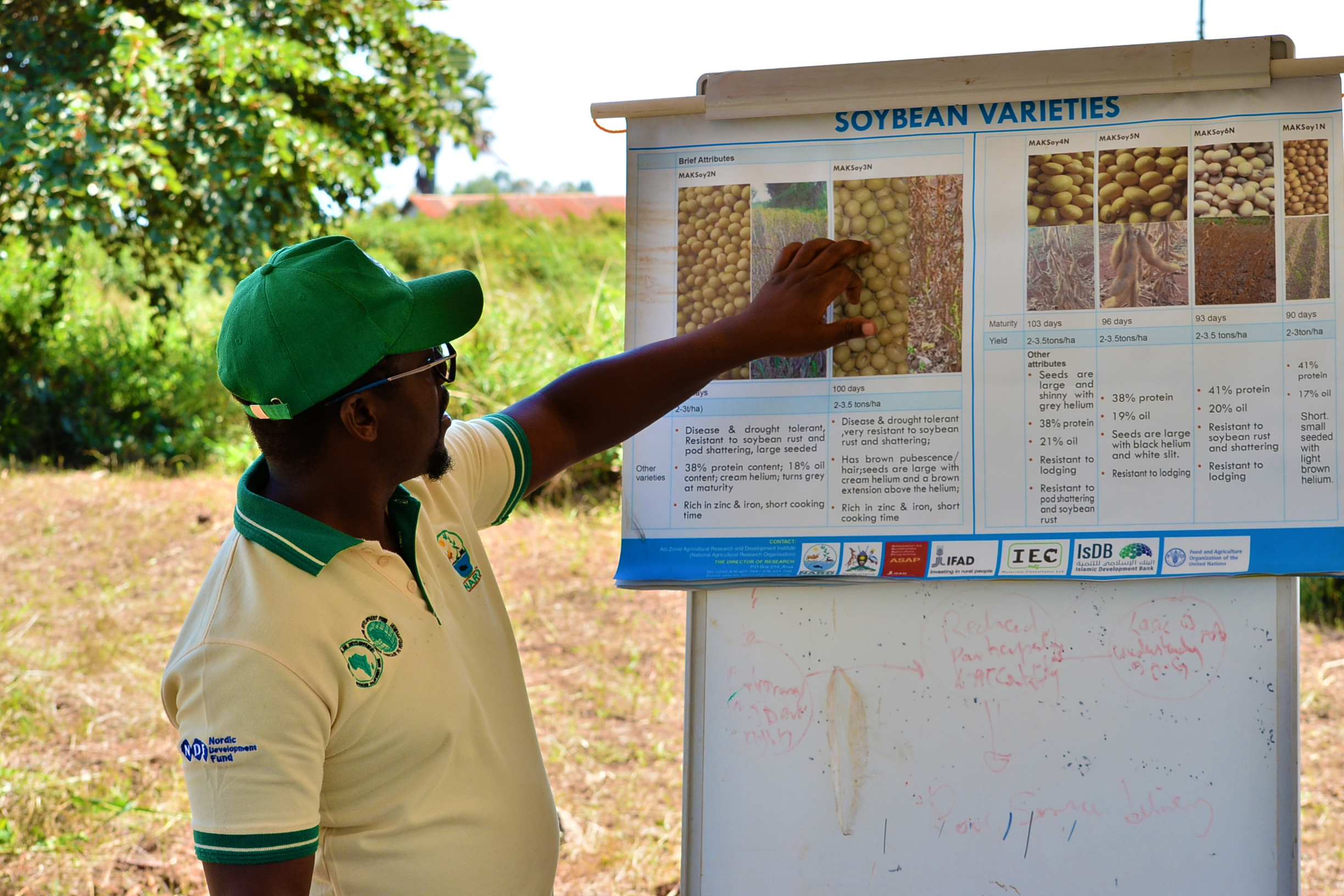Prime
The green and golden promise of soybean

Dr Moses Kiryowa, a soybean breeder teaches farmers about the seed varieties during the Seeds of Gold Farm Clinic in Arua. Photo/George Katongole
What you need to know:
- Policies, combined with efforts in education, variety development, agronomy, consumption promotion, marketing, and processing facilities, are needed to make soybean a premium commodity in Uganda’s agricultural landscape, potentially contributing significantly to the national economy.
During the recent Seeds of Gold Farm Clinic in Arua, a platform that brings together farmers, scientists, and enthusiasts to explore the endless possibilities of sustainable farming, Dr Moses Kiryowa, a soybean breeder, shared his invaluable insights into the world of soybean production and the boundless opportunities it holds for Uganda.
Dr Kiryowa, a soybean breeder at the National Legumes Research Program, stationed at the National Crops Resources Research Institute (NaCRRI) in Namulonge, is deeply involved in the advancement of soybean cultivation and research in Uganda.
“Soybean cultivation is more than simply sowing seeds; it’s about planting the seeds of nutrition and prosperity, fostering growth through agriculture,” Dr Kiryowa says.
Sowing the seeds
Soybean found its way into Uganda between 1918 and 1945, during the turmoil of the First and Second World wars.
Its introduction was primarily aimed at combating protein malnutrition among the King’s African Rifles (KAR) soldiers and addressing kwashiorkor in children, while also diversifying crop cultivation.
“This background created a lot of resistance and many people were not willing to grow the crop because it was forcibly introduced by the colonialists,” he says.
The earliest soybean research in Uganda can be traced back to the 1930s, leading to the release of Kabanyolo 1, Kabanyolo 2, and Congo 72 varieties. These varieties served the Ugandan communities until the 1990s when Nam 1, Nam 2, and Namsoy 3 were introduced and commercialised.
Unfortunately, a severe soybean rust epidemic in 1996 rendered these varieties obsolete due to their susceptibility to the disease.
For many years, soybean received limited attention and research support from the Ministry of Agriculture until the 1980s when the government began investing in research, although adaptability remained a challenge.
In Uganda, various food processing firms produce a diverse range of soybean-based products including soybean meal, soybean oil, and a variety of soy-based food products, such as energy boosters, baby food, chocolate, and more.
Initiatives like the Vegetable Oil Development Project (VODP) have added value to soybean alongside other crops like simsim and oil palm, serving both the animal feed and human food industries.
Collaborations between organisations such as Soynet, Makerere University, Naro, and others are actively working on developing soybean-related products, including soybean milk, flour, and coffee.
Progressive
Dr Kiryowa emphasises the need for innovative soybean products to boost its economic value, noting that its adoption in terms of food value is growing thanks to numerous partner organisations promoting consumption.
Uganda has made progress in soybean production, increasing from 23 metric tonnes in 2005 to 108 metric tonnes in 2018.
In 2022, the National Agricultural Research Organisation (Naro) initiated an ambitious 10-year strategic plan to reinvigorate the soybean industry. As part of this endeavor, Naro partnered with Makerere University to spearhead research efforts.
Furthermore, collaborative initiatives with organisations such as Heifer International and processors such as Smart Africa were set in motion.
This plan encompasses several key elements, including the integration of climate-smart soybean production technologies, the enhancement of soybean varieties tailored to farmers’ market and agro-industrial demands, the preservation of valuable soybean germplasm, the fortification of the soybean seed system, a drive to increase adoption, and the establishment of robust stakeholder networks.
Complementary strategies within the plan focus on optimising post-harvest handling, adding value to soybean products, and boosting the commercialisation of soybean and its derivatives.
A nutritional marvel
Soybean, scientifically known as Glycine max (L), is a versatile crop with various applications, from human and livestock nutrition to industrial uses.
“It can be used as an intervention in school feeding programs because of its wealth of nutrients. We need innovative products to make soy more useful in the economy,” Dr Kiryowa says.
According to the American Soybean Association, this crop yields an astonishing array of 27 whole bean products, 53 soy oil products, and 48 items derived from soybean flour/meal.
Dr Kiryowa underscores its paramount global significance as an outstanding oil crop. Notably, it stands as the most cost-effective source of protein for both human and livestock diets. Soybean’s protein content outshines that of other legume crops, averaging 40 percent on a dry matter basis.
What sets soybean protein apart is its impeccable balance of essential amino acids, complemented by substantial mineral content, including notable levels of iron, zinc, calcium, and magnesium.
The nutritional superiority of soybean flour positions it as an unrivalled substitute for animal and fish protein, rendering soy-based foods highly recommended for specific demographics such as children under five years, expectant mothers, and individuals affected by HIV.
Furthermore, soybean oil boasts of linoleic acid (an omega-3 fatty acid) and oleic acid. These components are renowned for their remarkable capacity to reduce the risk of heart disease, as they can lower serum cholesterol levels by approximately 33 percent.
Beyond its nutritional attributes, soybean also contains isoflavones, compounds celebrated for promoting arterial and heart health
In fact, as far back as 1999, the US Food and Drug Administration endorsed the daily consumption of 25 grammes of soy protein as a means to mitigate the risk of heart disease.
This longstanding recognition underscores the advantages of incorporating soybean and soy-based products into one’s diet for the betterment of health and well-being.
“Collaboration is the key to unlocking soybean’s full potential. We must bring together value chain players – processors, product developers, and exporters – to enhance the value of soybean” Dr Kiryowa says.
Constraints in Uganda
Despite its nutritional significance, soybean research faces funding challenges compared to staple crops such as cassava, rice, beans, and maize. Effective pest and disease control, particularly against soybean rust, is vital for high-quality soybean production.
The development of pest-resistant varieties is recommended as a cost-effective solution.
The Centre for Soybean Improvement and Development focuses on developing high-yield, disease-resistant, and nutrition-rich soybean varieties, collaborating with various stakeholders, including local governments, NGOs, seed companies, and research institutions.
Drought poses a significant challenge to smallholder soybean farmers in rain-fed farming systems. Selecting drought-tolerant varieties is complex due to soybean’s moisture-dependency. Climate changes affect rainfall patterns, impacting rain-fed agriculture.
Opportunities
Dr Moses Kiryowa says opportunities for soybean production in Uganda lie in prioritising soybean cultivation, and leveraging its potential to enhance nutrition and income.
While soybean stands as a cornerstone crop in industrialised nations such as the USA, Argentina, Brazil, and China, Uganda has not accorded it the attention it deserves in the past, despite its immense potential to elevate both nutrition and the incomes of its people.
Uganda possesses the capacity to yield competitive quantities of soybean, adeptly meeting the surging demand for both human sustenance and livestock feed. The global soybean oil market size reached 60MT in 2022.
Looking forward, market research firm IMARC Group expects the market to reach 67.6MT by 2028, exhibiting a growth rate of 1.9 percent during 2023-2028.
Soybean is recognised as the sixth most important crop in the world. With suitable soils and a tropical climate, Uganda can meet the growing demand for soybean as both human food and livestock feed.
Existing improved soybean varieties, such as Maksoy 3N, offer promising yields and oil content.




